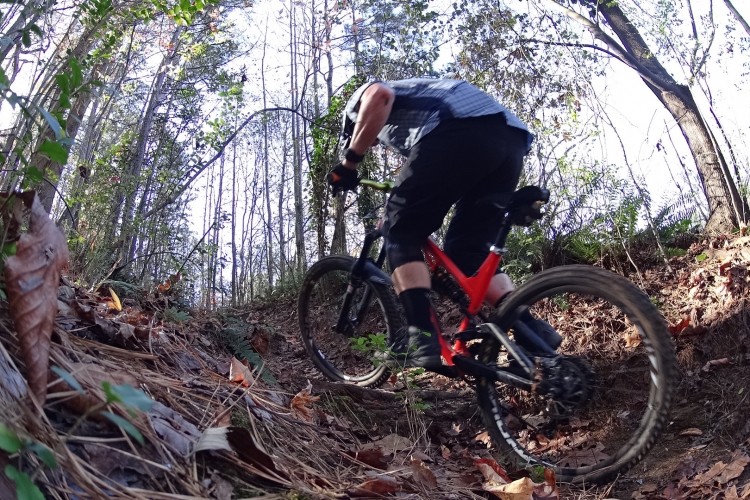
As Fizik’s premier XC racing saddle, the Tundra M1 cuts a slim profile, uses minimal padding, and weighs a scant 169g (165g claimed). To put that gossamer weight into perspective, a typical 29er tube weighs around 200g. Fizik hit that weight via a liberal use of carbon fiber in the shell of the saddle and in the rails. If you’re considering this saddle, you’ll need to make sure your seatpost is compatible with carbon and oval rails. I used the Tundra on a BikeYoke Revive dropper without issue.
The Tundra M1 measures 125mm wide by 290mm long, making it one of the narrowest and longest saddles I’ve ever used on a mountain bike. My personal go-to saddle is the WTB Silverado which measures 133mm x 274mm. I can’t say I noticed the difference in width, but the extra fore/aft room on the Tundra was quite apparent. Unlike the Silverado which has a recessed channel running the length of the saddle, the Tundra is totally flat on top.

Fizik uses two different types of Microtex for the cover. The material on the front of the saddle feels almost like suede and is very grippy, while the rear uses a glossy, smooth covering. Besides adding a little pizazz to the looks of the saddle, the materials serve a practical purpose, too. When you slide forward on the saddle as you would when climbing, the grippy nose keeps your bum in place. The slippery back allows you to easily slide off the saddle when descending and is less likely snag your shorts when getting back on.
You might think that such a light, race-oriented saddle would be uncomfortable, but that wasn’t my experience. The flat top offers plenty of real estate for sliding around while seated, and the nose never gets too pointy. When dropped, the slightly-rounded edges play nicely with the inner thigh and knee area. The Tundra provides a pleasant perch for pedaling on all but the longest seated climbs. Much of the credit for this comfort in the WingFlex technology Fizik uses. The carbon shell is co-injected with flexible nylon around the edges where your thighs contact the saddle, allowing your legs to move freely.

While the Tundra M1 is billed as a racing saddle, I used it exclusively on my trail hardtail, and I made no efforts to baby it. Over the course of several months, it has seen hundreds of miles, numerous botched landings, a handful of crashes, and slogs through terrible weather. The cover remains free from tears or holes, and it cleans up nicely. A very slight, intermittent creak developed towards the end of the test period, but that only occurs when heavily weighting the nose of the saddle.
Finish Line

The Tundra M1 is a pricey upgrade at $250, but that seems to be the going rate for a mostly-carbon saddle. WTB has carbon versions of several of their saddles, all of which cost $250 as well. If weight is your main concern, the WTB SL8 is a little lighter at 150g, but it’s substantially shorter than the Tundra at just 255mm long. Its tapered, pointy nose and heavily-rounded profile make it feel even smaller. I thought the Tundra M1 was significantly more comfortable than the SL8 and right on par with the Silverado. Based on my experience and the lack of stitching on the cover, I’d say the Tundra is one of the most durable saddles I’ve tried.
If all that sounds good but the high price tag gives you pause, Fizik offers the Tundra in a couple different configurations starting at $99.
[offer keyword=’fizik tundra m1′]
Thanks to Fizik for providing the Tundra M1 for review.



















